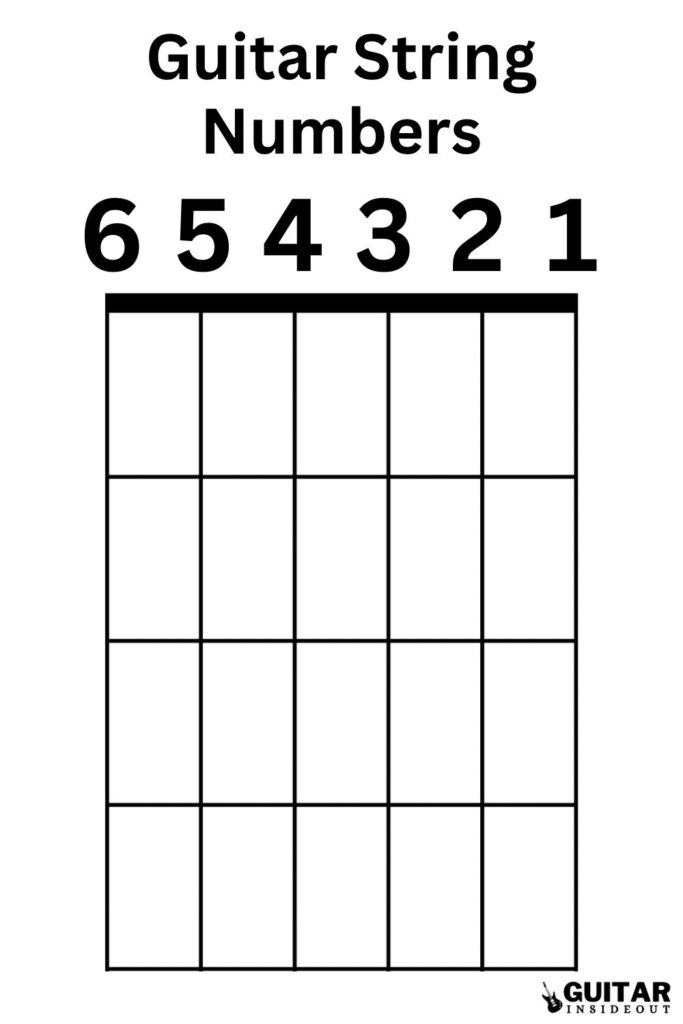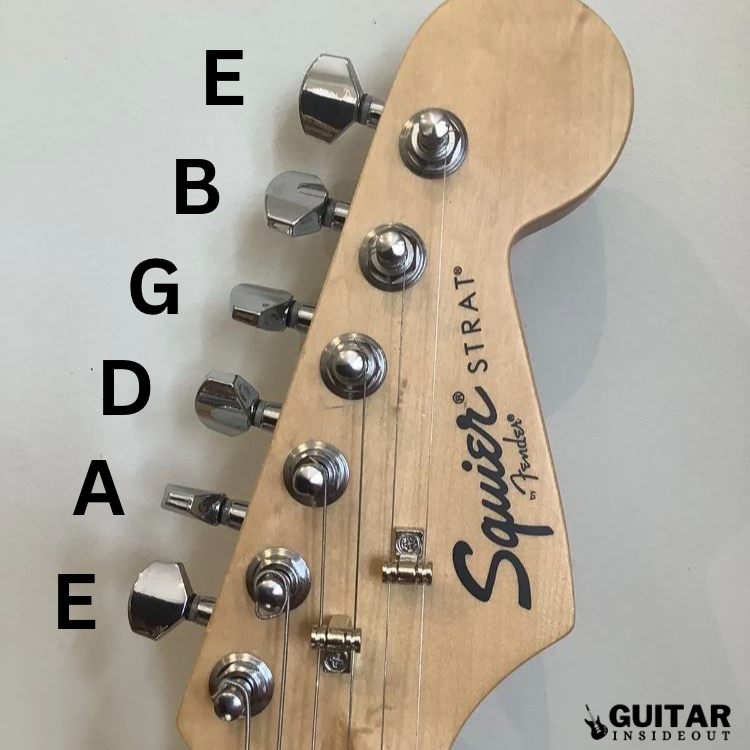Learning the order of the guitar strings as well as their names and numbers is something you should have memorized as soon as possible. It might be boring but it’s a fundamental piece of knowledge that is only going to help with understanding the guitar.
I took far longer than I should I have to learn them, especially considering how basic it is. Why? Well a little bit of laziness, a reliance on tabs where you don’t really need to know anything and a lack of clever acronym or rhyme to help.

But if you dedicate even a small amount of time to it then you can have them memorized without any problem. And it will be worth it: for reading chord diagrams, tuning your guitar, learning the notes on the fretboard and more you have to know the names and numbers of the strings.
So let’s go through the guitar strings order, the string names and string numbers as well as useful tips for memorizing them.
Guitar String Numbers
The guitar strings are numbered fairly simply. You just have to commit them to memory.
There are 6 strings on a regular electric and acoustic guitar. The thinnest string (high E) is the 1st string and you count up from there to the thickest string (low E) which is the 6th string.
So the order the guitar strings goes is like this:
- High E – 1st string
- B – 2nd string
- G – 3rd string
- D – 4th string
- A – 5th string
- Low E – 6th string

You might find that slightly counterintuitive because the thickest string is at the top of the fretboard and the one you put your first finger on. It’s easy to think of that thick, low E string as the 1st.
But try to remember it the right way round. With only a little effort you’ll have it memorized in no time and won’t have to think twice about it.
Guitar String Names
The names of the guitar strings is also very straightforward. The tuning determines the note names of each string and as standard tuning is the most common that’s what we’ll use here to demonstrate.

So, the thinnest string, or first string, is an E. The second is B, third G, fourth D, fifth A and the sixth string, the thickest, is an E.
- 1st string – High E
- 2nd string – B
- 3rd string – G
- 4th string – D
- 5th string – A

Bass Guitar String Names
The Bass guitar uses the same first 4 strings as the guitar, so:
- 1st string – G
- 2nd string – D
- 3rd string – A
- 4th string – E
For a 5 string bass you either have an additional low string, which would be a B, or an additional high string, a C.
How to Memorize the Guitar Strings Order
The best way to remember the guitar strings order and their names is with a mnemonic. A mnemonic device is where you take something like letters, in this case the letters of the guitar strings, and create a pattern that helps you remember them.
So you can use the EAGBDE of the strings and make a sentence or phrase that you will remember.Here’s a few examples:
- Every Apple Does Go Bad Eventually
- Eat A Darn Good Breakfast Everyday
- Eat All Day Get Big Easy
- Elvis Ate Drugs Good Bye Elvis
- Every Acid Dealer Gets Busted Eventually
- Every Adult Dog Growls Barks Eats
- Ed Always Drinks Guinness Before Exercising
- Eddie Ate Dynamite Goodbye Eddie
- Every American Dollar Goes Bad Eventually

You can try remembering them just by playing the guitar and practising. For example if you’re looking at your electronic tuner every day with each of the string names or seeing the letters above chord diagrams you can pick them up that way.
But using a mnemonic like the ones above or one you come up with yourself and making an effort to memorize them will definitely help you remember the strings on the guitar quicker.
Why are the Strings in that Order?
It’s tempting to answer this with a very simple “because”. A lot of the time it’s a better idea not to ask “why” and just accept things the way they are.
But that’s not very informative, is it? So here’s a very basic explanation:
A lot of it comes down to it being easier. Unlike most other stringed instruments that are tuned in fifths the guitar is tuned in fourths (and a major third).
What that means is the intervals between each string is five semitones (fourths) and four semitones (a third), or in the case of those other stringed instruments, six semitones (perfect fifths). Tuning in fifths limits the number of strings the instrument needs, which is why instruments like violins only have 4 strings.
But by tuning in fourths the guitar requires 6 strings and that results in there being many more notes. This allows you to play a far greater number of notes as well as chords that contain more notes.
It also makes playing the guitar easier. If it were tuned differently, like in all fifths, the stretch you would have to make to form chords would be a whole lot more difficult (and painful!).
Basically standard tuning just works for the guitar. It makes it simpler to play and gives you more options for creating harmonies and chords.
Before you go…
For more information about learning the guitar try these articles:
How Long Does it Take to Learn Guitar? A Realistic Guide
Parts of a Guitar: it’s Anatomy Explained
Related Articles